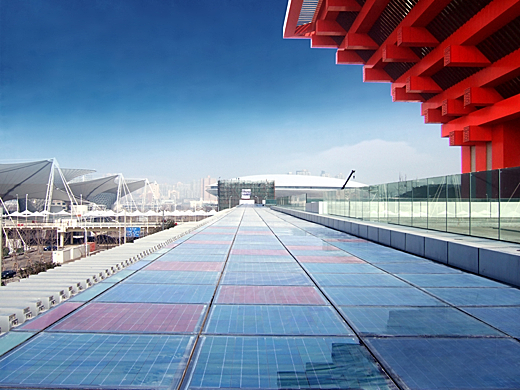
Image above: Hunan Sunzone Optoelectronics 250KW installation at World Expo 2010 Shang China Pavilion. From (http://www.sunzone-energy.com/productShowen.asp?pro_id=182).
[Publisher's note: The United States and Europe would be wise to follow China's example and subsidize alternative energy manufacture with heavy taxes on fossil fuel companies. To hell with the W.T.O.]
By Keith Bradsher on 9 September 2010 in New York Times -
(http://www.nytimes.com/2010/09/09/business/global/09trade.html)
Until very recently, Hunan Province was known mainly for lip-searing spicy food, smoggy cities and destitute pig farmers. Mao was born in a village on the outskirts of Changsha, the provincial capital here in south-central China.
Now, Changsha and two adjacent cities are emerging as a center of clean energy manufacturing. They are churning out solar panels for the American and European markets, developing new equipment to manufacture the panels and branching into turbines that generate electricity from wind. By contrast, clean energy companies in the United States and Europe are struggling. Some have started cutting jobs and moving operations to China in ventures with local partners.
The booming Chinese clean energy sector, now more than a million jobs strong, is quickly coming to dominate the production of technologies essential to slowing global warming and other forms of air pollution. Such technologies are needed to assure adequate energy as the world’s population grows by nearly a third, to nine billion people by the middle of the century, while oil and coal reserves dwindle.
But much of China’s clean energy success lies in aggressive government policies that help this crucial export industry in ways most other governments do not. These measures risk breaking international rules to which China and almost all other nations subscribe, according to some trade experts interviewed by The New York Times.
A visit to one of Changsha’s newest success stories offers an example of the government’s methods. Hunan Sunzone Optoelectronics, a two-year-old company, makes solar panels and ships close to 95 percent of them to Europe. Now it is opening sales offices in New York, Chicago and Los Angeles in preparation for a push into the American market next February.
To help Sunzone, the municipal government transferred to the company 22 acres of valuable urban land close to downtown at a bargain-basement price. That reduced the company’s costs and greatly increased its worth and attractiveness to investors.
Meanwhile, a state bank is preparing to lend to the company at a low interest rate, and the provincial government is sweetening the deal by reimbursing the company for most of the interest payments, to help Sunzone double its production capacity.
Heavily subsidized land and loans for an exporter like Sunzone are the rule, not the exception, for clean energy businesses in Changsha and across China, Chinese executives said in interviews over the last three months.
But this kind of help violates World Trade Organization rules banning virtually all subsidies to exporters, and could be successfully challenged at the agency’s tribunals in Geneva, said Charlene Barshefsky, who was the United States trade representative during the second Clinton administration and negotiated the terms of China’s entry to the organization in 2001.
If the country with the subsidies fails to remove them, other countries can retaliate by imposing steep tariffs on imports from that country. But multinational companies and trade associations in the clean energy business, as in many other industries, have been wary of filing trade cases, fearing Chinese officials’ reputation for retaliating against joint ventures in their country and potentially denying market access to any company that takes sides against China.
W.T.O. rules allow countries to subsidize goods and services in their home markets, as long as those subsidies do not discriminate against imports. But the rules prohibit export subsidies, to prevent governments from trying to help their companies gain in world markets.
The W.T.O. also requires countries to declare all national, state and local subsidies every two years, so that if one country’s exports surge suspiciously, other countries’ trade officials can easily check to see if that product is being subsidized.
But China has virtually ignored the requirement since joining the W.T.O. Contending that it is still a developing country struggling to understand its commitments, China has filed just one list of subsidies, which were in place between 2001 and 2004. And that one list covered only central government policies while omitting local or provincial subsidies.
The Chinese mission to the W.T.O., which is part of China’s commerce ministry, would not comment for this article. After reading questions The New York Times submitted by fax last week, mission officials declined to respond, saying that any comments might affect China’s standing in other trade disputes.
Sunzone and other Chinese clean energy companies also benefit from the fact that the government spends $1 billion a day intervening in the currency markets so that Chinese exports become more affordable in foreign markets. Systematic intervention in currency markets to obtain an advantage in trade violates the rules of the International Monetary Fund, of which China is a member, although the I.M.F. has little power to punish violators.
Chinese wind and solar power manufacturers further benefit from the government’s imposition of sharp reductions this summer in exports of raw materials, known as rare earths, that are crucial for solar panels and wind turbines. China mines almost all of the world’s rare earths....[Article cont. at p.2 p.3 p.4 Next Page »]
.
1 comment :
Nice picture, Juan. Looks like a Chinese modern-day picture out of the future.
Post a Comment